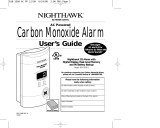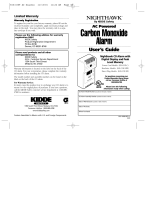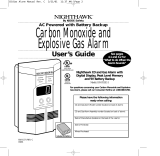Interconnect Feature
Your Combination Smoke/CO Alarm is interconnectable to other
multiple station Kidde, Nighthawk and Kidde/Fyrnetics products:
• When compatible smoke alarms and heat alarms are
interconnected to your Smoke/CO Alarm, they will only
respond to a smoke related event.
• When mixing compatible models with battery backup with
models without battery backup, be advised that the models
without battery backup will not respond during an AC power
failure.
• This unit is only approved to interconnect with other
Kidde/Nighthawk products. It is NOT approved to interconnect
with any other brand of detection product.
• This alarm is interconnect compatible with the following alarms
and accessories:
– Smoke alarms: 1235, 1275, 1276, 1285, 1296, i12020,
i12040, i12060, i12080, PE120, PI2000, PI2010
KN-COSM-IB, KN-COSM-I, KN-SMFM-I, and RF-SM-ACDC.
Firex: 4618, 4518, 4480, 460 and 484.
Kidde/Firex: i4618, i4718, and i5000
– Heat alarm: HD135˚F
– CO alarms: KN-COB-IC, KN-COP-IC, KN-COPF-I
– Relay modules: 120X, SM120X, CO120X
– Strobe Light: SL177i
See User’s Guides for specific application information.
• For more information about compatible interconnect units and
their functionality in an interconnect system, visit our web site
at www.kidde.com.
HUSH Control Feature
The HUSH feature has the capability of temporarily desensitizing
the smoke alarm circuit for approximately 10 minutes. This
feature is to be used only when a known alarm condition, such
as smoke from cooking, activates the alarm. You can put your
Smoke/CO Alarm in HUSH mode by pushing the test/reset
button. If the smoke is not too dense, the alarm will silence
15
Operating Instructions

























